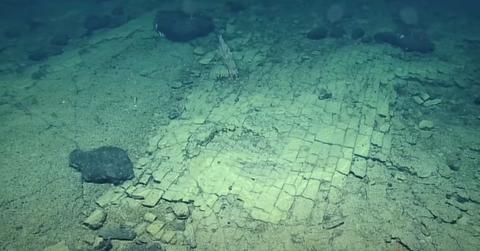Scientists Follow the "Underwater Yellow Brick Road," Discovered on the Pacific Ocean Floor
Published May 10 2022, 12:57 p.m. ET
The Little Mermaid and The Wizard Of Oz may be two completely different stories, but the two worlds have officially collided IRL.
On April 29, the Exploration Vessel Nautilus captured footage of the Liliʻuokalani Ridge in the Pacific Ocean's Papahānaumokuakea Marine National Monument, and it looks exactly like an undersea yellow brick road. The photos and videos have left many wondering how this unique formation came to be.
This finding has many of us questioning if there truly is more life than we realize under the sea.
"Is Atlantis real? Has it ever been found? Where is Atlantis? As there are no definite answers to these questions, Atlantis is still known as a fictional island mentioned in an allegory on the hubris of nations in Plato's works Timaeus and Critias," a report from Times Now News reads.
But scientists think they know what may have caused this natural phenomena to form.
"Finding Atlantis may still be a dream, but we can tell you for sure that a group of marine scientists has discovered a strange yellow brick path at the bottom of the Pacific Ocean," the story continues. Needless to say, it's a fascinating find.
What caused the underwater yellow brick road?
Although we truly wish this "yellow brick road" was built by a handy crew of marine munchkins, that sadly isn't the case. In fact, it wasn't even manmade.
As per CNET, the Exploration Vessel Nautilus team had been studying undersea mountains and volcanoes, and though they initially thought this was part of a dried lake bed, it was really hyaloclastite rock which had erupted with gusto, and settled along the seabed. It formed a brick-like pattern, because the rock heated and cooled that way.
The crew basically describes it as “an example of ancient active volcanic geography," according to NDTV. It's the result of many eruptions, over the course of centuries.
“At the summit of Nootka Seamount, the team spotted a 'dried lake bed' formation, now ID'd as a fractured flow of hyaloclastite rock — a volcanic rock formed in high-energy eruptions where many rock fragments settle to the seabed,” the caption of EVN's YouTube post reads.
The Exploration Vessel Nautilus vessel is run by Ocean Exploration Trust, a nonprofit which aims to educate those interested in deep sea finds. They frequently post livestreams that show what the remote-operated vehicle witnesses in the depths of the ocean. Along with the "yellow brick road," the EVN has witnessed unique octopuses and other undersea creatures, showing what really happens deep beneath the waves.
Why is this type of research useful?
Although this simply seems like a fun and whimsical find, it could help scientists see how the deep sea changes over time.
Mother Earth is constantly changing due to climate change and other factors, but much of the changes are recorded on land. Of course we're aware of coral bleaching, which is triggered by rising temperatures, as well as erosion, which is often due to rising sea levels.
But exploring the depths of the ocean could certainly tell us a few things about where our planet will be in years to come, based on these types of discoveries.
A lot of volcanic activity can also be triggered by climate change, and looking at how they've reacted under water Therefore, we're excited to see what EVN finds next.
